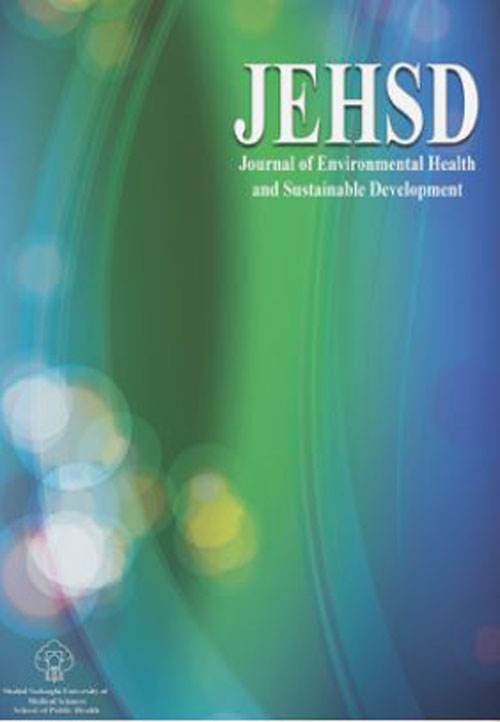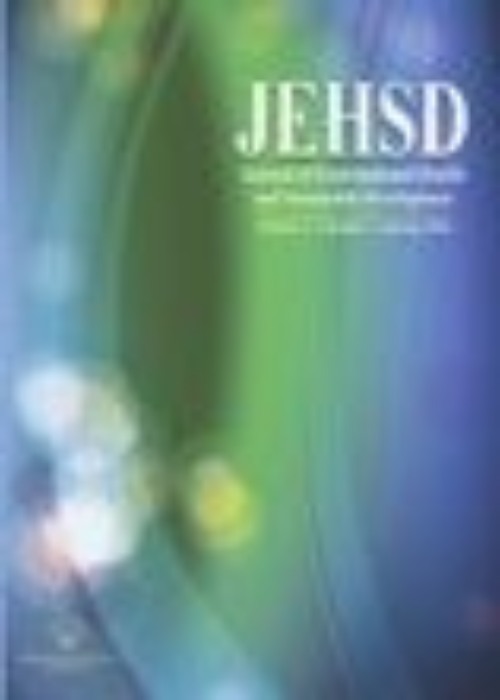فهرست مطالب

Journal of Environmental Health and Sustainable Development
Volume:4 Issue: 3, Sep 2019
- تاریخ انتشار: 1398/06/10
- تعداد عناوین: 8
-
Pages 804-812IntroductionExposure to mercury (Hg) by consumption of fish is a recent health concern. So, it is important to evaluate the health risks related to canned fish consumption. The purpose of this study was to investigate the potential health risk based on Hg concentration in people who consumed canned fish with a probabilistic approach in Isfahan City, the central province in Iran.Materials and MethodsIn this study, 20 popular brands of canned fish prepared in Iran and other countries were selected and analyzed for Hg concentration with atomic absorption spectrometer. The results were compared with the European Communities and JECFA guidelines. Then, a probabilistic method with Monte-Carlo simulation was used to assessment the Provisional Tolerable Daily Intake (PTDI) and the Hazard Quotient (HQ) for consumers in Isfahan City.ResultsThe average Hg concentrations in samples were 0.251 ± 0.204 and 0.189 ± 0.152 µg/g in canned fish of Iran and other countries, respectively. The Hg level was found below the guideline limit for European Communities and JECFA. The estimated PTDI was 0.037 µg person/day and HQ was 0.074.ConclusionThe results indicated that canned fish available in the markets of Iran did not have a health risk for adults. Moreover, canned fish consumption has a possible influence on the risk estimate and its risk should be assessed for vulnerable groups.Keywords: Mercury, Fish, Risk Assessment, Monte-Carlo Simulation
-
Pages 813-818IntroductionAs recommended by World Health Organization, consumption of the fungal contaminated water does not cause to serious infection, but may lead to healthy or aesthetic problems. The aim of this research was to assess the occurrence of fungi in water and its relationship with fecal indicator bacteria.Materials and Methods110 water samples were collected from different location of water distribution systems in Aliabad-e Katul City, North of Iran during April to November 2018. Enumeration of coliforms bacteria and fungi were performed by multiple tube fermentation and membrane filtration method, respectively; as described in Standard Methods.ResultsOur results showed that fungi and total coliform were detected in 31 (28.4%) and 26 (23.9%) samples, respectively. Among samples of fungi positive, 22 (20.2%), 7 (6.4%), and 5 (4.6%) water samples were positive for Aspergillus sp., Rhizopus sp., and Penicillium sp., respectively. However, none faecal coliform and E. coli were observed in all examined samples, proposing the absence of faecal pollution in water. The mean and SD residual chlorine and pH were 0.55 ± 0.23 (mg/l) and 7.30 ± 0.30, respectively. The statistical analysis showed a remarkable difference between the prevalence of total coliforms and fungal species (P < 0.001).ConclusionPresence of potential opportunistic pathogens fungi in potable water can be considered as a health risk, especially for immuno-suppressed individuals. Therefore, cleaning the processes such as biofilm removal and addition of the free chlorine concentration can be effective to decrease fungi contamination and total coliform from water distribution system.Keywords: Drinking Water, Fungi, Water Microbiology, Water Quality
-
Pages 819-833Introduction
Pyrene and phenanthrene are polycyclic aromatic hydrocarbons (PAHs) are priority pollutants. The aim of this study was to investigate the ability of isolated bacteria from stabilized compost for biodegradation of pyrene and phenanthrene from soil contaminated with municipal solid waste leachate.
Materials and MethodsIn this study, phenanthrene and pyrene were selected as priority PAHs pollutants. The degrading bacteria of these compounds were isolated from the stabilized compost and their ability to remove different concentrations of pyrene and phenanthrene investigated. The remaining concentrations of pyrene and phenanthrene were measured by GC-MS. The growth kinetics of bacteria were also studied using a spectrophotometer at 595- nm wavelength. One-way ANOVA was used to determine the statistical significance and plot the related curves, and the Excel software and SPSS version 24 to do statistical analysis.
ResultsThe most potent bacteria in removing pyrene and phenanthrene were Paenibacillus and Bacillus, respectively. The concentrations to be studied were determined as 10, 25, 40 and 55 μg/kg according to the concentrations of PAHs in the soil contaminated with municipal solid waste leachate. At constant temperature of 30 °C after 30 days at these concentrations, the removal efficiency was, respectively, 96.3%, 83%, 77.8%, and 72.4% for pyrene and 100%, 99.6%, 95.9%, and 94.6% for phenanthrene. The growth kinetics of phenanthrene-exposed bacteria were better than those of pyreneexposed bacteria.
ConclusionThe results show that bacteria in stabilized compost are able to remove pyrene and phenanthrene. The bacteria of the highest efficiency for removal of pyrene and phenanthrene are Paenibacillus and Bacillus, respectively.
Keywords: Polycyclic Aromatic, Environmetal Pollution, Biodegradation, Pyrene, Phenanthrene -
Pages 834-842IntroductionDue to water scarcity and increased water consumption during the past years, the importance of water in terms of transmission of diseases, as well as Iran's climate, groundwater aquifers are known as the most important resources of drinking water supply. Using the Water Quality Index (WQI) is considered as strong managerial tool for decision making in water resource management. Therefore, the aim of this study was to evaluate the quality of groundwater in Ardakan for drinking purpose using WQI. Spatial analysis was conducted with the geographic information system (GIS).Materials and MethodsThis is a descriptive, cross-sectional study to investigate the quality of groundwater in Ardakan for drinking purpose. Information on total dissolved solids (TDS), total hardness, pH, electrical conductivity (EC), bicarbonate (HCO3-), chlorine (CL-), sulfate (SO42-), nitrate (NO3-), calcium (Ca2+) and magnesium (Mg2+) of 24 wells was obtained from Ardakan Health Center. The characteristics of the stations were determined using the Global Positioning System (GPS) and transmitted to the map prepared in the GIS environment. The calculated values of the WQI were zoned in the GIS environment by Inverse Distance Weighted (IDW) method.ResultsBased on the WQI, well no.5 has the best quality water (17.61), which has the lowest WQI, and the highest value of WQI was obtained for well no. 20 (156.86).ConclusionThe results of the study showed that none of wells have drinkable water, 13 wells had good quality water, and 11 wells had poor quality and should be treated for drinking.Keywords: Water Quality Index, Ardakan City, Geographic Information Systems, Drinking Water, Water Supply
-
Pages 843-850IntroductionDisposal of the wastewater produced in the paper and paperboard industry without the refining process can add substances to the environment, which are harmful to humans, environment, and other organisms. With regard to process efficiency, the current methods used in wastewater treatment of this industry are economically unjustifiable. Therefore, in this research, the electrolysis / electrocoagulation method was investigated using a graphite / iron electrode for synthetic aqueous solutions containing golden yellow X-GL.Materials and MethodsIn this test, two Plexiglas reactors with a volume of 3 liters were used. The impact of the operation parameters such as voltage, initial dye concentration, and reaction time were investigated. Dye concentration in specimens was determined by visible spectrophotometry using DR-5000 at 438nm wavelength.ResultsIn optimal conditions of voltage 12V, dye concentration 10 mg/l, and time 60 min, the removal efficiency rates of electrolysis reactors, electric coagulation, and combined reactor were 64.17%, 75.42%, and 84.19% respectively. By increasing the dye concentration and decreasing the voltage, the dye removal efficiency decreased.ConclusionThe electric coagulation process using an iron electrode is a suitable method for removing the yellow color of colored aqueous solutions from the paper and paperboard industry.Keywords: Electrolysis, Electrocoagulation, Golden yellow X-GL
-
Pages 851-858IntroductionThe biological denitrification process is an interesting cost-effective technique to remove nitrate from water supplies. Acetic acid can be used as a carbon source in this process, but its consumption rate is a critical issue and, in some cases, it is quite different from stoichiometric constants. The current study aimed to investigate the nitrate removal in an up-flow packed bed bioreactor. Furthermore, various parameters affecting this process were investigated and optimized. In this study, the autotrophic bacteria were used for the heterotrophic process.Materials and MethodsInitially, the autotrophic bacteria were cultured and used for the following heterotrophic conditions in distinct reactors. A pilot-scale anoxic up flow bioreactor packed was constructed using the polyethylene media and applied to remove nitrate from the aqueous environment. Consequently, the effects of hydraulic retention times (HRT) and different acetic acid concentrations as carbon source were evaluated. During the study, the amounts of alkalinity, pH, temperature, and nitrate were checked.ResultsThe designed bioreactor removed an average of over 88% of nitrate, while the acetic acid consumption was 2 mg/mg NO3-N, which was lower than the stoichiometric constant for heterotrophic process. Moreover, in the three studied HRTs (1.5, 3, and 5 h), the Alkalinity increased from 14.2 to 19.8 %.ConclusionThe results of this study showed high efficiency in nitrate removal via heterotrophic denitrification using acetic acid as carbon source for autotrophic bacteria.Keywords: Nitrate Removal, Heterotrophic Denitrification, Acetic acid


